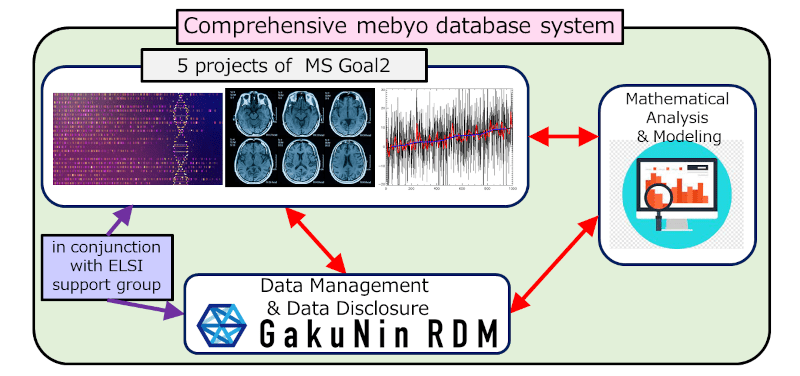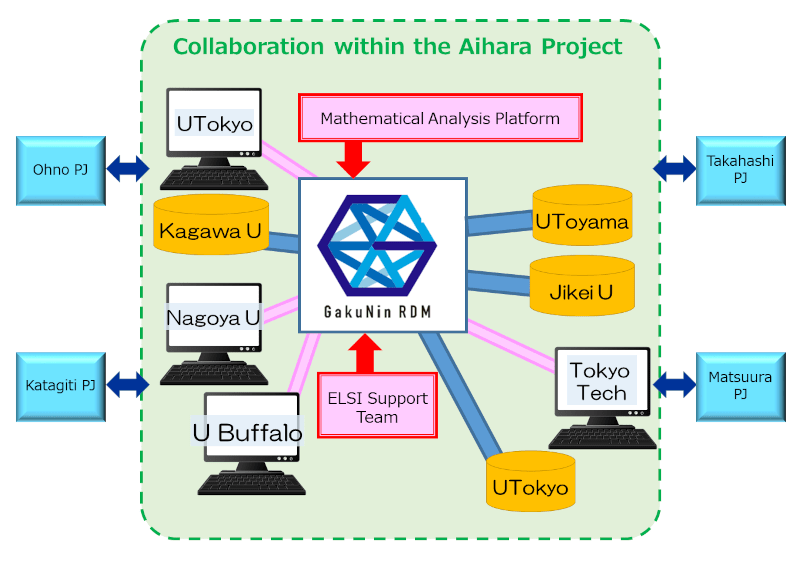Progress Report
Comprehensive Mathematical Understanding of the Complex Control System between Organs and Challenge for Ultra-Early Precision Medicine[3] Mathematical Collaboration with Other Moonshot Projects, Development of Data Base, and ELSI Supporting System
Progress until FY2024
1. Outline of the project
This R&D Item can be divided into two sub-themes: One is "Mathematical Collaboration with other Moonshot Projects" and the other is "Database Construction”. Mathematical collaboration involves the construction of a mathematical analysis infrastructure that can be used across the entire Moonshot Goal 2, as well as mathematical collaboration on disease data obtained in Goal 2. In particular, we will construct a comprehensive mathematical analysis method for detecting the pre-disease state (Mebyo) just before the transition from a healthy state to a diseased state.

In addition, the database construction aims to compile the results of the entire projects, construct a comprehensive Mebyo database of complex organ regulatory systems, and make it widely available to society. In collaboration with all the projects in Moonshot Goal 2, we will construct this comprehensive Mebyo database based on experimental data, clinical data, and cross-sectional mathematical analysis data related to various diseases.
Through these efforts, we will contribute not only to the project's goals of comprehensive mathematical understanding of complex organ regulatory systems and early precision medicine, but also to the realization of a society capable of predicting and preventing diseases in the ultra-early stages, which is the goal of Moonshot Goal 2 as a whole.
2. Outcome so far
In the mathematical collaboration, the construction of mathematical analysis methods and the development of mathematical analysis software have been conducted in order to start analyzing the experimental and clinical data that will be measured in the five projects under MS Goal 2. For example, software has been developed and released for the Aihara Project's original mathematical analysis methods, such as DNB analysis and ASURAT. The released software has been tested on the GakuNin RDM, and it has been verified that the software can be used for the entire Moonshot Goal 2. Thus, the construction of the mathematical analysis platform is steadily progressing and a part of the platform is already working well.
In addition, in database construction, we have completed the design of a Moonshot Goal 2 database and have begun collecting and sharing experimental and clinical data from all the five projects. The database working group has been organized to concretely collaborate toward the use of the database for the entire Goal 2 project. In addition, we are co-working closely with the ELSI supporting team to consider appropriate responses to ethical, legal, and social issues (ELSI) that may arise in comprehensive Mebyo database construction. We have also made database guidelines to resolve ELSI in the database construction.

3. Future plans
In mathematical collaborative research, we will continue to build a data sharing system to continue promoting mathematical collaboration within each project and across all the projects under MS Goal 2. In addition, we will also keep constructing a mathematical analysis platform that can be easily used across the entire Goal 2. By releasing various mathematical analysis methods as software that can be used by everyone in Goal 2, it is expected that mathematical collaboration will be highly promoted.
As for the database construction, data sharing within MS Goal 2 will be promoted as soon as possible. To this end, we will continue to resolve issues related to data sharing and develop database functions. In addition, we will work with the ELSI supporting team in our project to improve database guidelines in order to establish common usage methods and rules for the comprehensive Mebyo database construction toward realization of ultra-early diagnosis and treatment.